2017-18's Top 50 Defenses: Virginia Is Set Up to Shut Everyone Else Down
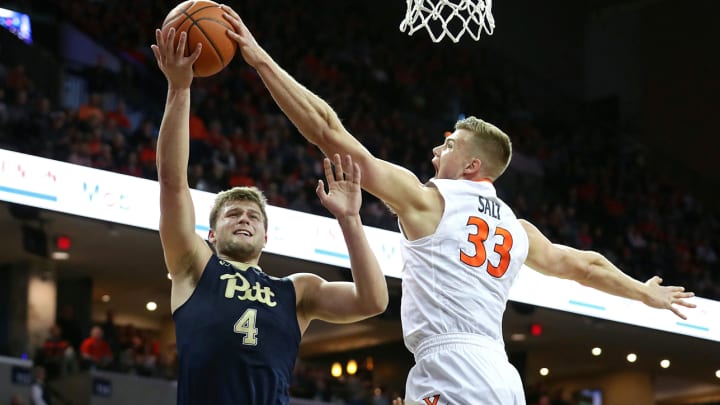
Sports Illustrated’s 2017-18 college basketball projections are a collaboration between economist Dan Hanner, SI’s Chris Johnson and SI’s Jeremy Fuchs. The system uses college and AAU statistics, recruiting rankings and coaching data to project every Division I player and team. For a deeper look at how the system works, read this explainer. SI’s ranking of teams 1-351 has been more accurate than similar 1-351 rankings produced by ESPN, CBS Sports and noted analyst Ken Pomeroy for three consecutive years.In the next installment of our preview, we’re analyzing the best 50 defenses in the country.
Defense is far more difficult to project than offense. While blocks, steals, height (particularly in the paint), athleticism, the number of elite recruits in the lineup and coaching history all have some predictive power, our model for offense is about four to six times as accurate as our model for defense. There are so many things that impact team D that simply are not measured—from communication to effort to minor injuries that limit lateral or vertical movement. As the NCAA tournament approaches and you begin your bracket preparation, here’s a tip if you’re trying to make sense of teams that have surprisingly outperformed or failed to meet expectations: Unanticipatedly strong or poor defense is usually the reason why.
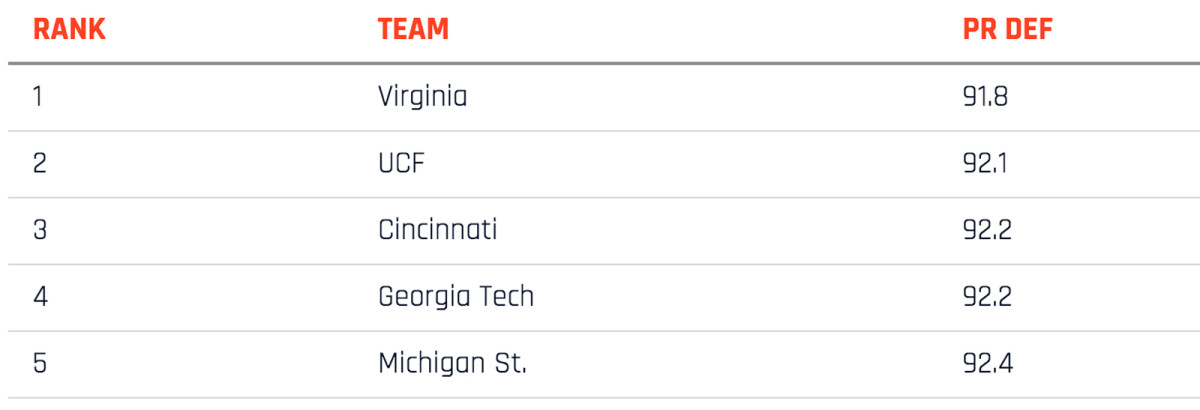
Tony Bennett’s pack-line defense is a riddle that ACC teams cannot solve. Virginia has played top-10 D in five of the last six seasons, and we project that forwards Isaiah Wilkins and MamadiDiakite, as well as center Jack Salt, will have the ’Hoos in the No. 1 spot this year. One big reason—literally—why UCF is projected as the No. 2 defense in the nation is height, especially at the center position, where UCF’s 7' 6" junior, Tacko Fall, is one of the most impactful big men in the sport. Fall blocked 11% of opponents’ two-point field goal attempts while he was on the floor as a sophomore in 2016–17. Nick Ward was one of the premier shot-swatters in the Big Ten last season when he managed to avoid foul trouble, and Michigan State’s (No. 5) top recruit, five-star power forward Jaren Jackson Jr., is a plus defender.
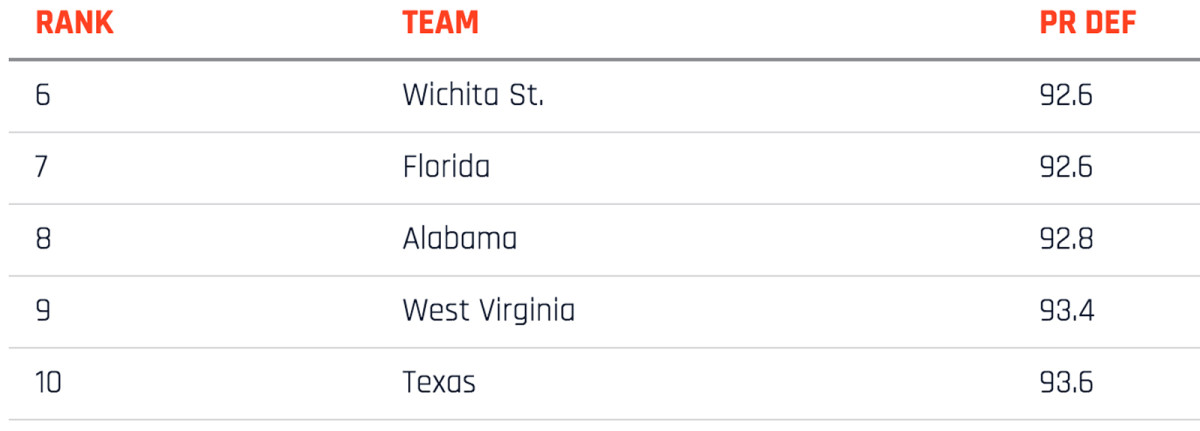
Gregg Marshall’s recent defensive history stacks up favorably to most head coaches, and it would be a huge shock if he can’t put together another elite D given Wichita State (No. 6) returns every major contributor from last season. Alabama (No. 8) was sneakily stingy last season, and it brings back a high-end rim protector in Donta Hall, for whom we project a substantial bump in playing time after he logged only 48.5% of available minutes in 2016–17. West Virginia (No. 9) turned opponents over on a higher percentage of its possessions than any other Division I team in 2016–17, and the Mountaineers will spend another year relentlessly pressing teams until they cough up the ball, an effort spearheaded by the player who ranked third in the Big 12 in steal rate during conference play as a junior, Jevon Carter.
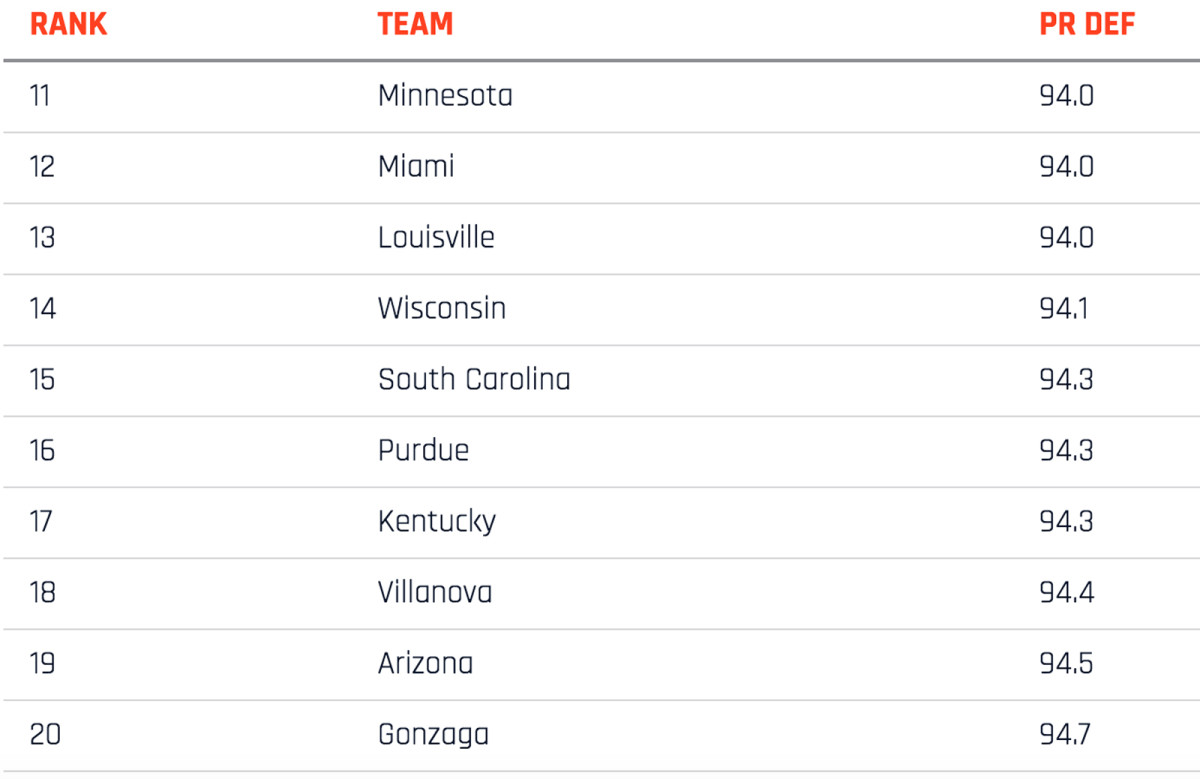
Minnesota (No. 11) got a boost last season from a low opponent three-point shooting percentage, a statistic over which teams have little control, but ace shot-blocker Reggie Lynch will prop up the Golden Gophers’ two-point defense. Purdue (No. 16) won’t have Caleb Swanigan around to hoard opponents’ missed shots, but pretty much everyone else of note will be back from the squad that rated out second in the Big Ten defensively during conference play. Maybe the most notable feature of Kentucky’s (No. 17) loaded recruiting class is its length: Shai Gilgeous-Alexander, P.J. Washington, Kevin Knox, Jarred Vanderbilt (expected to be out until January with a left foot injury) and Nick Richards all have wingspans measured at seven feet or longer. Teams aren’t going to have an easy time finding good looks against the Wildcats, despite the heavy roster turnover they underwent this offseason.
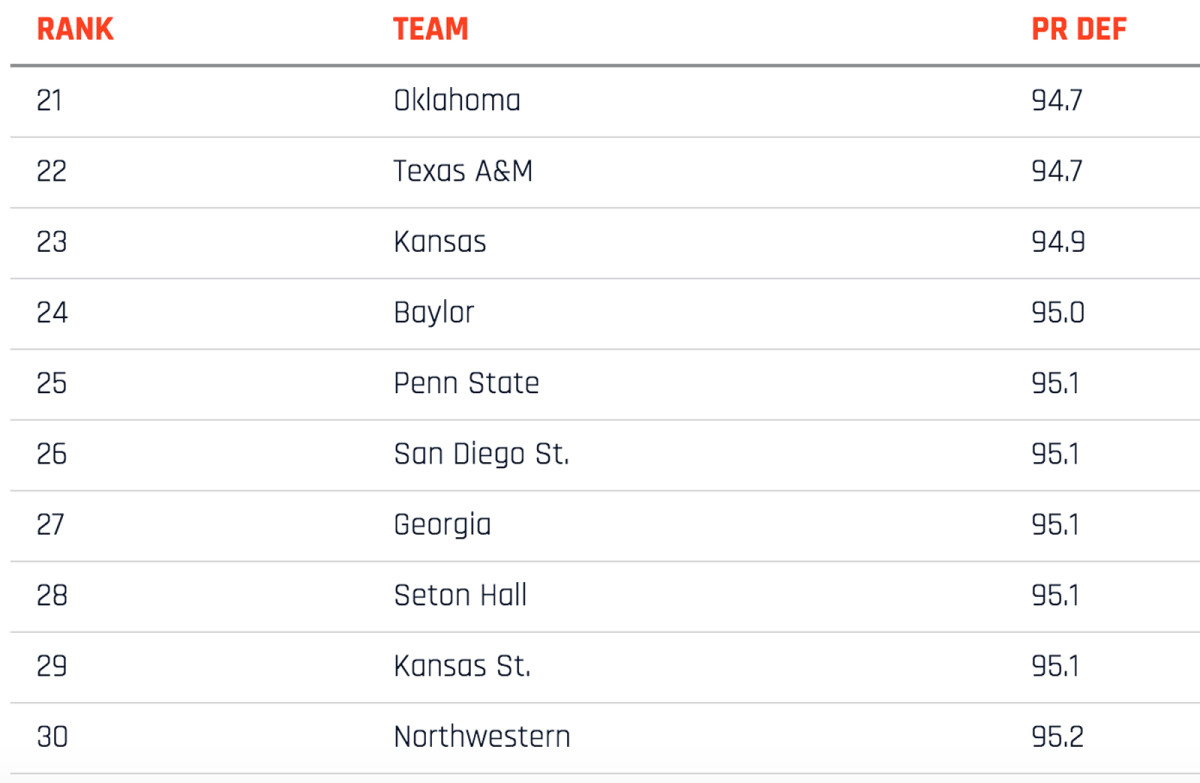
The two teams at the top of this section both will be anchored by top-shelf shot-blockers: Oklahoma’s (No. 21) Khadeem Lattin led the Big 12 by swatting 10.6% of opponents’ attempts inside the arc during league play last season, and Texas A&M’s (No. 22) Robert Williams, a projected top-10 pick in the 2018 NBA draft, ranked second in the SEC at 10.1%. Losing Johnathan Motley, an offensive workhorse who was named first-team all-Big 12 in 2017, will definitely hurt Baylor (No. 24), but its top shot-blocker, Jo Lual-Acuil, is back for another season. No Big East player was more effective at ending opponents’ possessions with defensive rebounds last season than Seton Hall’s (No. 28) Angel Delgado. Prepare to watch he and the rest of a stout supporting cast smother the Pirates’ conference foes in low-scoring slogs. Northwestern (No. 30) didn’t lose much from the first NCAA tournament team in program history, and in Dererk Pardon and Gavin Skelly, head coach Chris Collins can roll out two disruptive interior defenders.
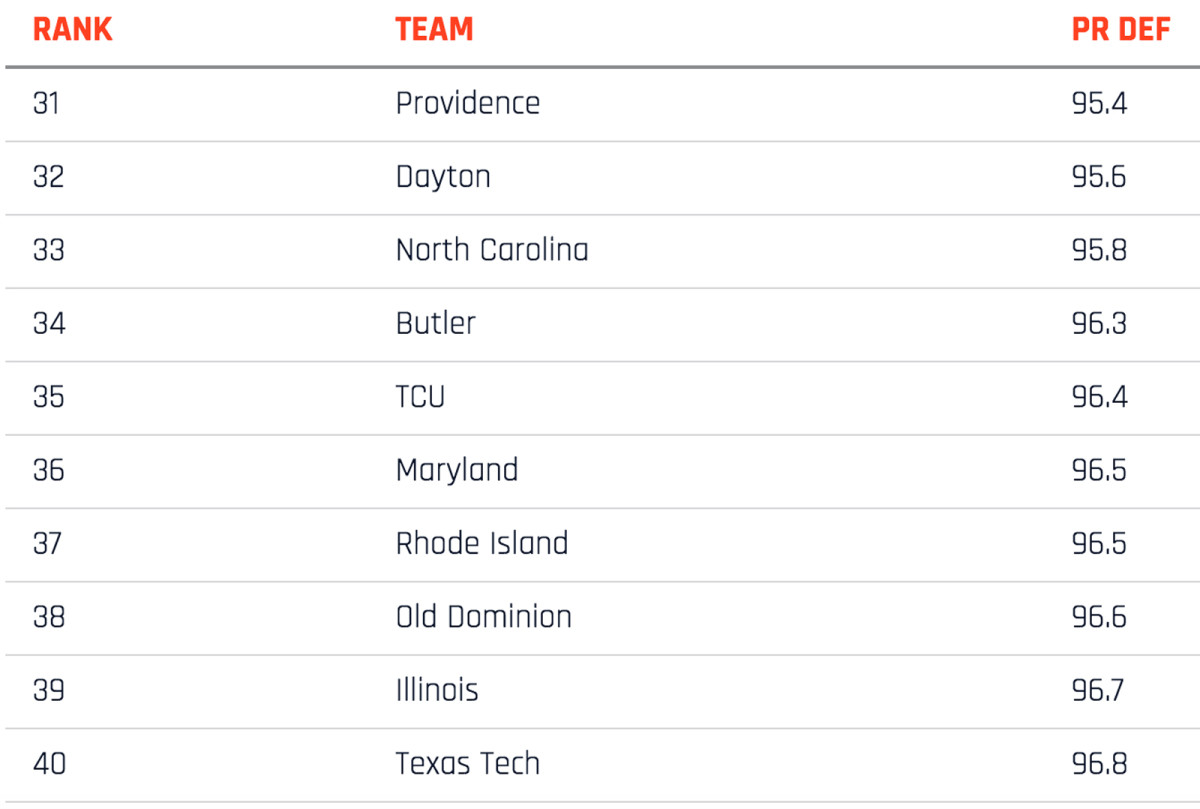
North Carolina’s (No. 33) defensive prospects for this winter were hit hard by frontcourt personnel departures: Not only did big men starters Kennedy Meeks and Isaiah Hicks run out of eligibility, but also key reserve Tony Bradley decided to enter the draft after only one college season. Last season, LaVall Jordan’s first as a head coach, his Milwaukee team posted one of the worst defensive efficiency ratings in the Horizon League during conference play. The former Butler guard’s first year in charge of the Bulldogs (No. 34) should include a better showing on that end of the floor, thanks in part to Kamar Baldwin, who registered one of the Big East’s top steal rates as a freshman in 2016–17. Maryland (No. 36) was worse defensively when star Melo Trimble was on the floor last season, and he’s moved on to the NBA now, leaving in place a strong sophomore class including a big-time three-and-D prospect in Justin Jackson, plus a promising shot blocker who should see the floor more often as a senior: 7' 1" Michal Cekovsky.
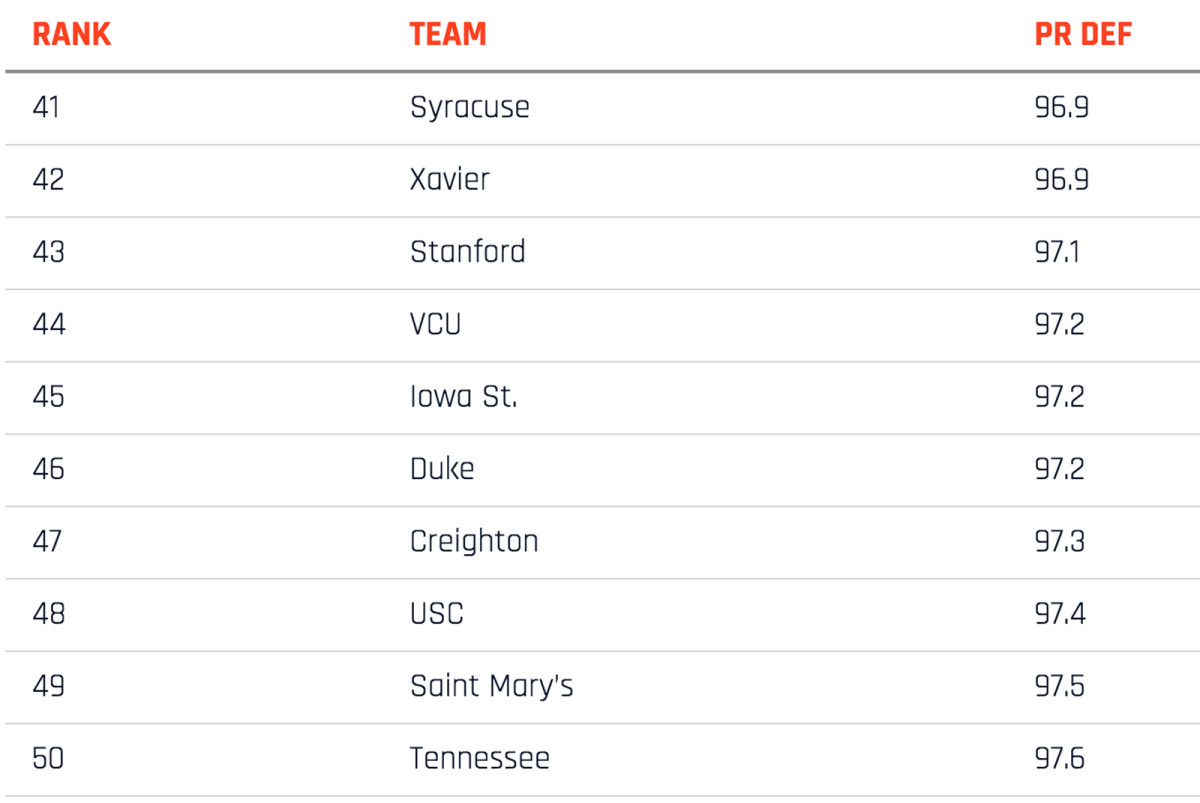
Syracuse (No. 41) was uncharacteristically poor on defense last season, but much like with Virginia’s pack-line, our model has a favorable view of Jim Boeheim’s 2–3 zone. While the Orange roster has more holes than usual, Boeheim remains a premier defensive coach. (Their defensive projection would be even higher had they had not lost rim protector Taurean Thompson to a late-summer transfer.) After revealing earlier that we project Duke (No. 46) to lead Division I in offensive efficiency, here’s a grimmer piece of news regarding the Blue Devils: They aren’t pegged to finish nearly as highly on defense. Marvin Bagley III, the No. 1 prospect in the class of 2017, according to the RSCI, ranked third in Nike’s Elite Youth Basketball League this year in blocks per game, and another five-star power forward recruit headed to Durham, Wendell Carter Jr., is a prolific rebounder. So, Mike Krzyzewski does have some pieces to put together a stout D, but he has not demonstrated the same ability as Kentucky’s John Calipari to coax elite defensive play from a freshman-heavy rotation. The Pac-12 will have to contend with a more experienced version of basically the same USC (No. 48) defense it faced last season, and chances are teams won’t make 36.8% of their threes against the Trojans again.
